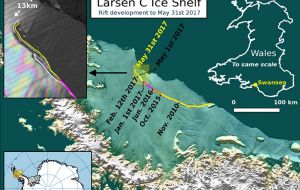MercoPress. South Atlantic News Agency
Antarctica largest iceberg ever, ready to break off from the Larsen C ice shelf
 The crack now has just 8 miles to go before an iceberg roughly the size of the state of Delaware breaks free into the Southern Ocean.
The crack now has just 8 miles to go before an iceberg roughly the size of the state of Delaware breaks free into the Southern Ocean.  ”Larsen C may eventually follow the example of its neighbor Larsen B, which disintegrated in 2002 following a similar rift-induced calving event.”
”Larsen C may eventually follow the example of its neighbor Larsen B, which disintegrated in 2002 following a similar rift-induced calving event.” The long-growing crack in the Larsen C ice shelf, one of Antarctica’s largest floating platforms of ice, appears to be reaching its inevitable end. Scientists with Project MIDAS, working out of Swansea University and Aberystwyth University in Wales and studying the shelf by satellites and through other techniques, have released a new update showing that the crack grew a stunning 11 miles in the space of just one week between May 25 and May 31.
It now has just 8 miles to go before an iceberg roughly the size of the state of Delaware breaks free into the Southern Ocean.
“There appears to be very little to prevent the iceberg from breaking away completely,” the researchers write. Elsewhere in their post, they note that the crack has now curved towards the front of the ice shelf and the ocean, meaning that the time when a major break could occur “is probably very close.”
The researchers have estimated that the section of ice set to break off could be around 2,000 square miles in area.
“When it calves, the Larsen C Ice Shelf will lose more than 10% of its area to leave the ice front at its most retreated position ever recorded; this event will fundamentally change the landscape of the Antarctic Peninsula,” write the Project MIDAS team.
“We have previously shown that the new configuration will be less stable than it was prior to the rift, and that Larsen C may eventually follow the example of its neighbor Larsen B, which disintegrated in 2002 following a similar rift-induced calving event.”
The prospect of an enormous iceberg afloat in the seas around Antarctica could draw further attention to the threat of climate change at a time when President Trump’s is considering whether to exit the Paris agreement to reduce greenhouse gas emissions.
An ice shelf is the floating extension of a glacier that itself grows from the land out into the ocean. The loss of a large iceberg from Larsen C would not raise the sea level, since the ice is already afloat. However, the thinning and loss of ice shelves leads glaciers to flow more rapidly into the sea, and as ice is transferred from atop the land into the water, sea levels will rise somewhat.
However, there is not nearly as much ice held behind Larsen C as there is behind other glaciers in East and West Antarctica, which have also begun to lose mass in recent decades.




Top Comments
Disclaimer & comment rulesCommenting for this story is now closed.
If you have a Facebook account, become a fan and comment on our Facebook Page!